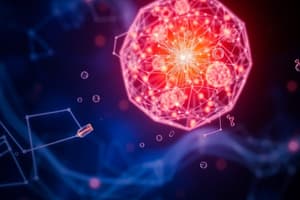Podcast
Questions and Answers
What is the primary function of cones in the eye?
What is the primary function of cones in the eye?
- Transmit visual information to the brain
- Provide depth perception
- Photoreception in low light conditions
- Photoreception for bright light conditions (correct)
The optic chiasm is responsible for switching information from the upper and lower visual fields.
The optic chiasm is responsible for switching information from the upper and lower visual fields.
False (B)
What causes a visual blind spot in the eye?
What causes a visual blind spot in the eye?
The lack of photoreceptor cells where the optic nerve exits the eye.
The three tiny bones in the middle ear are called the ______.
The three tiny bones in the middle ear are called the ______.
Match the types of depth perception cues with their definitions:
Match the types of depth perception cues with their definitions:
According to the trichromatic theory of color vision, which colors are combined to create all colors in the visible spectrum?
According to the trichromatic theory of color vision, which colors are combined to create all colors in the visible spectrum?
The inner ear contains the semicircular canals, which are involved in hearing.
The inner ear contains the semicircular canals, which are involved in hearing.
What is the role of retinal ganglion cells?
What is the role of retinal ganglion cells?
Which of the following best defines sensation?
Which of the following best defines sensation?
Transduction refers to the process of interpretation of sensory information.
Transduction refers to the process of interpretation of sensory information.
What is the absolute threshold?
What is the absolute threshold?
The process through which our brain organizes and interprets sensory information is called ______.
The process through which our brain organizes and interprets sensory information is called ______.
Which of the following is an example of bottom-up processing?
Which of the following is an example of bottom-up processing?
Subliminal messages are those that are presented at a level above conscious awareness.
Subliminal messages are those that are presented at a level above conscious awareness.
Match the sensory modalities with their corresponding processes:
Match the sensory modalities with their corresponding processes:
When stimuli remain constant over time and no longer produce perception, this phenomenon is known as ______.
When stimuli remain constant over time and no longer produce perception, this phenomenon is known as ______.
What is the primary function of hair cells in the cochlea?
What is the primary function of hair cells in the cochlea?
Place theory suggests that different frequencies of sound are detected by different locations on the basilar membrane.
Place theory suggests that different frequencies of sound are detected by different locations on the basilar membrane.
What are the two types of auditory cues used for sound localization?
What are the two types of auditory cues used for sound localization?
The fluid inside the cochlea moves to stimulate the ______ cells.
The fluid inside the cochlea moves to stimulate the ______ cells.
Match the type of hearing loss with its description:
Match the type of hearing loss with its description:
Which part of the auditory system is primarily involved in balance and movement?
Which part of the auditory system is primarily involved in balance and movement?
The temporal theory of pitch perception relies solely on the location of sound on the basilar membrane.
The temporal theory of pitch perception relies solely on the location of sound on the basilar membrane.
What happens to sound waves when they reach the eardrum?
What happens to sound waves when they reach the eardrum?
What is a symptom of Meniere’s disease?
What is a symptom of Meniere’s disease?
Taste information is transported to the olfactory bulb.
Taste information is transported to the olfactory bulb.
Name the five basic taste groups.
Name the five basic taste groups.
The chemical messages sent by another individual are called ______.
The chemical messages sent by another individual are called ______.
Which of the following is NOT a function of olfactory receptor cells?
Which of the following is NOT a function of olfactory receptor cells?
Match the sensory receptors with their responses:
Match the sensory receptors with their responses:
Cochlear implants are a treatment option for ring loss.
Cochlear implants are a treatment option for ring loss.
What structures detect stretch in the skin?
What structures detect stretch in the skin?
What type of pain results from damage to the neurons of the nervous system?
What type of pain results from damage to the neurons of the nervous system?
Congenital analgesia is a condition where an individual can feel pain normally.
Congenital analgesia is a condition where an individual can feel pain normally.
Name one main sensory organ responsible for the vestibular sense.
Name one main sensory organ responsible for the vestibular sense.
The perception of the body's movements is known as ______.
The perception of the body's movements is known as ______.
Which of the following best describes the Gestalt Principle of Proximity?
Which of the following best describes the Gestalt Principle of Proximity?
The law of closure states that we tend to perceive broken lines as complete objects.
The law of closure states that we tend to perceive broken lines as complete objects.
What is the main function of the vestibular organs?
What is the main function of the vestibular organs?
Match the following concepts with their definitions:
Match the following concepts with their definitions:
Flashcards are hidden until you start studying
Study Notes
Sensation vs. Perception
- Sensation is the physical process of detecting stimuli, while perception is the psychological interpretation of those stimuli.
- Sensory receptors are specialized neurons that detect specific stimuli, initiating the sensation process.
Transduction
- Refers to the conversion of sensory stimulus energy into action potentials.
- Examples of stimuli: vision, taste (gustation), hearing, touch, smell (olfaction), balance (vestibular sense), and temperature (thermoception).
Absolute Threshold
- The minimum amount of stimulus energy required for detection 50% of the time, indicating the sensitivity of a sensory system.
Subliminal Messages
- Messages presented below the threshold of conscious awareness, often called "hidden messages."
Just Noticeable Difference (JND)
- The minimum difference in stimuli required for detection, exemplified by the ease of spotting a bright screen in darkness compared to daylight.
Perception Processes
- Sensory information is organized, interpreted, and consciously experienced.
- Involves bottom-up processing (building perception from sensory input) and top-down processing (interpretation influenced by prior knowledge).
Sensory Adaptation
- The phenomenon where perception diminishes over time for constant stimuli.
Attention
- Plays a crucial role in sensation and perception, determining which stimuli are focused on.
Visual System Anatomy
- Retinal Ganglion Cells: Connect rods and cones, sending visual information through the optic nerve to the brain.
- Optic Chiasm: Crosses visual information from the left and right visual fields before reaching the occipital lobe.
- Blind Spot (Scotoma): Area lacking photoreceptors where the optic nerve exits the eye.
Color and Depth Perception
- Color Vision:
- Trichromatic Theory: All colors result from red, green, and blue combinations.
- Opponent-Process Theory: Color is registered in opponent pairs, leading to afterimages when the stimulus is removed.
- Depth Perception:
- Binocular cues involve both eyes (binocular disparity).
- Monocular cues provide depth information with one eye (e.g., linear perspective).
Auditory System Anatomy
- Pinna: Outer ear structure contributing to sound capture.
- Ossicles: Three tiny bones (malleus, incus, stapes) in the middle ear that amplify sound vibrations.
- Cochlea: Fluid-filled structure in the inner ear where sound waves stimulate hair cells, generating neural signals.
Pitch Perception
- Temporal Theory: Sound perception relates to the frequency of temporal patterns of hair cell action potentials.
- Place Theory: Different frequencies excite specific areas of the basilar membrane.
Sound Localization
- Monaural Cues: Sound location based on one ear's perception.
- Binaural Cues: Sound localization using both ears, focusing on interaural level and timing differences.
Hearing Loss
- Deafness: Partial or complete inability to hear, which may be congenital or due to age and environmental factors.
- Sensorineural Hearing Loss: Results from the failure to transmit signals from the cochlea to the brain, often related to Meniere’s disease.
Chemical Senses
- Taste (Gustation): Five primary tastes (sweet, salty, sour, bitter, umami); taste buds transport signals to the central nervous system.
- Smell (Olfaction): Odor molecules bind to olfactory receptor cells, signaling via the olfactory bulb to the limbic system.
Touch, Thermoception, and Nociception
- Various receptors in the skin respond to touch:
- Meissner’s corpuscles (pressure), Pacinian corpuscles (temporary pressure), Merkel’s disks (light pressure), Ruffini corpuscles (stretch).
- Pain perception can be inflammatory or neuropathic; congenital analgesia refers to a rare inability to feel pain.
Vestibular Sense, Proprioception, and Kinesthesia
- Vestibular Sense: Maintains balance and posture, utilizing structures like the utricle, saccule, and semicircular canals.
- Proprioception: Awareness of body position.
- Kinesthesia: Perception of body movement.
Gestalt Principles of Perception
- Gestalt theory emphasizes that the brain organizes sensory input into coherent forms:
- Figure-Ground Relationship: Segmentation of visual input into figures and background.
- Proximity: Objects close together are grouped.
- Similarity: Similar objects are grouped.
- Law of Continuity: Preference for continuous lines over jagged patterns.
- Closure: Organizing perceptions into complete objects instead of incomplete parts.
Studying That Suits You
Use AI to generate personalized quizzes and flashcards to suit your learning preferences.




